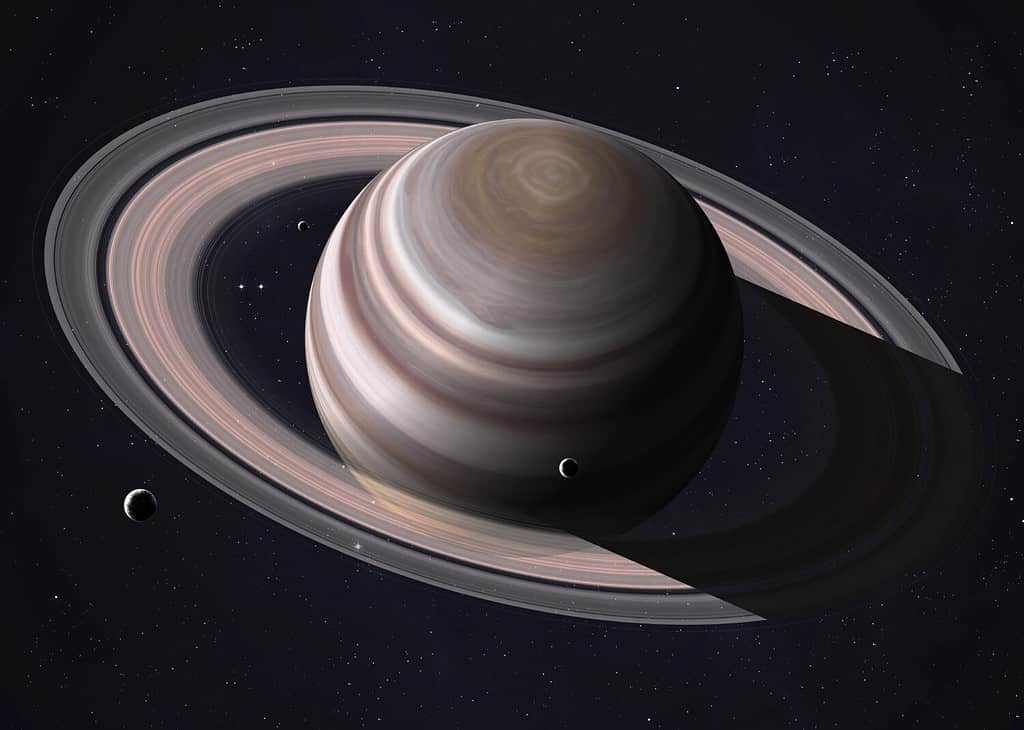The sixth planet from our fiery sun and the second largest planet in our solar system, Saturn is the farthest planet the human eye can see without extra help from a telescope or other tools. This massive planet has an average radius that is about nine and one-half times the size of Earth. However, it is only one-eighth as dense. That is because Saturn is made up mostly of hydrogen and helium, with a rocky center core.
Saturn has a pale-yellow hue, which is created by the ammonia crystals that float in its upper atmosphere. However, it is most famous for the stunning and intricate rings that encircle it like a large crown. It also has dozens of moons orbiting around it like its own little galactic subjects. So, how did Saturn get its name? Let’s take a closer look at this iconic planet and discover the origin and meaning of the planet’s name!
How Did Saturn Get Its Name?
Just like so many of us today, ancient people often gazed up at the twinkling lights in the sky above and pondered their own place in the vast universe. It’s hard to say just how early humans discovered Saturn, but the ancient Greeks and Romans knew about it. Ancient astronomers noticed that these bright lights in the sky moved around in relation to other stars and gave them the name “planētēs,” which meant “wanderer”. They named each of the planets they could see in honor of some of their most powerful gods (Mercury, Venus, Mars, Jupiter, and Saturn).
Each of these five planets was named for the Roman deity who held the most sway over it. Saturn’s name comes from Saturnus, the god of the Capitol, agriculture, time, liberation, and wealth. According to Roman mythology, Saturn was the god who taught the Roman people how to sow the land with seeds and grow crops. He was also the god of time. The planet Saturn orbits the Sun the slowest of all the planets. So, its name was given as a tribute to the ancient god who embodied the steady march of time and its seasons.

Saturn has seven stunning and complex rings around it.
©Vadim Sadovski/Shutterstock.com
The Roman God Saturn
Ancient Roman art and literature typically depict Saturn holding wheat in his right hand and a sickle in his left hand. The ancient Romans celebrated and honored Saturn each year during Saturnalia, or the Festival of Saturn. This was the largest and most popular festival for the ancient Romans. Each December the people gathered together to feast and party their hearts out. During Saturnalia, all work and business came to a halt. Even slaves were granted temporary freedom to do as they pleased. Certain moral boundaries were loosened, allowing people to speak their minds without worrying about retribution, and many people exchanged gifts.
In addition, the Temple of Saturn in the Roman Forum served as a bank and archive library for the Roman Republic and the early Roman Empire. Saturday also gets its name from the Roman god Saturn and was originally called “Saturn’s Day” in ancient Rome.
As the Roman Empire spread, the people assimilated the Greek gods with their own. Thus, Saturn became identified with the Greek titan, Cronus — aka, Zeus’ dad!

Saturn was an important god in Ancient Rome. The Temple of Saturn is at the base of Capitoline Hill.
©BAHDANOVICH ALENA/Shutterstock.com
The Moons of Saturn
Did you know that Earth is not the only planet in our solar system with a moon? In fact, Saturn has over 100 different moons! Scientists and philosophers began naming some of Saturn’s moons after the brothers and sisters of Saturn/Cronus — the titans and titanesses of Greek and Roman mythology.
For example, the largest of Saturn’s moons is Titan, the second largest is Rhea, and the third is Lapetus.
Titan almost seems like a planet because of its gigantic size. It is 50% bigger and 80% heavier than our own Moon! This massive moon is actually the second largest in our solar system. It is even larger than Mercury, but not as heavy.
Titan is also extra special because it has a thick atmosphere and clear evidence of stable bodies of surface liquid, similar to those on Earth. Its climate creates many surface features that are rather Earth-like, like seas, lakes, rivers, deltas, and dunes. It even has weather patterns that follow the seasons!

Saturn’s largest moon is Titan, which has a radius of almost 1,600 miles.
©iStock.com/Elen11
Who Discovered Saturn? What Was It Originally Called?
We do not really know who first discovered Saturn, but the oldest records we know of come from the Assyrians in 700 B.C.E. They called Saturn the “Star of Ninib” and described it as a shimmering planet with rings. The Greeks called it Cronus, while the Romans called it Saturn. Galileo Galilei saw Saturn’s rings while looking through his telescope in the 1600s and thought that it was actually a triple planet. In 1979, the Pioneer 11 spacecraft flew by Saturn for the very first time. And, for the past several years, the Cassini spacecraft has been on a mission to explore Saturn, allowing scientists to study the planet up close.
The photo featured at the top of this post is © iStock.com/EzumeImages
Thank you for reading! Have some feedback for us? Contact the AZ Animals editorial team.






